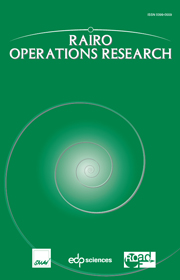Article contents
Un couplage entre un algorithme génétiqueet un modèle de simulation pour l'ordonnancement à court termed'un atelier discontinu de chimie fine
Published online by Cambridge University Press: 15 August 2002
Abstract
In this paper, a discrete-event simulation model iscoupled with a genetic algorithm to treat highly combinatorialscheduling problems encountered in a production campaign of a finechemistry plant. The main constraints and features of fine chemistryhave been taken into account in the development of the model, thusallowing a realistic evaluation of the objective function used in thestochastic optimization procedure. After a presentation of problemcombinatorics, the coupling strategy is then proposed and illustrated byan example of industrial size (24 equipment items, 140 products, 12different production recipes and 40 products to be recycled during thecampaign). This example serves as an incentive to show how the approachcan improve production performance. Three technical criteria have beenstudied: campaign completion time, average product cycle time, respectof due-dates. Two kinds of optimization variables have been considered:product input order and/or allocation of heuristics for conflittreatment. The results obtained are then analysed and some perspectivesof this work are presented.
- Type
- Research Article
- Information
- Copyright
- © EDP Sciences, 1999
- 2
- Cited by


